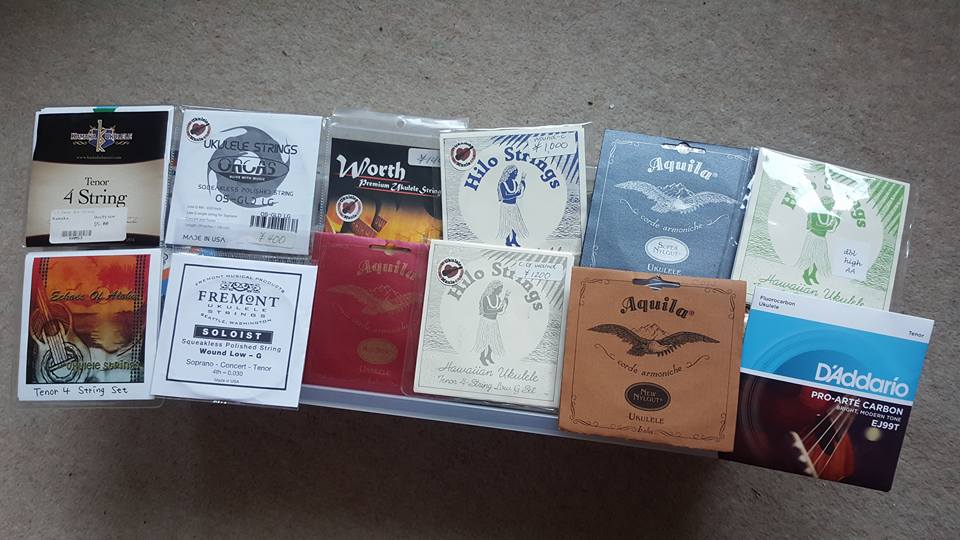Just as all ukuleles are not the same, all ukulele strings are not the same either! In recent months I have been experimenting with a number of different types with some fascinating results…
The ukulele is of course a small bodied instrument and depending on the construction, each instrument can sound completely different. My background in acoustic guitars has been useful in broadly identifying how instruments will sound. For example a mahogany constructed ukulele will sound very different to one made from koa or maple. The latter two woods tend to result in a brighter sound.
The type of strings in combination with these woods can totally change the sonic character of the instrument. In this blog I’ll offer my own observations on what I have found and the result of these string/wood combinations. It’s also useful to remember that the size of the instrument is going to also be a major factor in the overall sound.
Better Red?
Probably the best known and respected ukulele strings in the UK are the Italian made Aquila made strings. These are great sounding and in my experience an extremely reliable choice. There is also a wide range of options. I’m a fan of low G sets of strings and one of my favorite sets are “The Red Series”. These unsurprisingly are red in colour and here’s a promotional clip talking about these – https://www.youtube.com/watch?v=wckA0zDk5cU#t=106
I use these on my Collings pre-production concert ukulele and they sound wonderful. They use some copper in the construction of these strings and in my view they work really well with a mahogany constructed instrument. They definitely colour the sound, so that’s both “the good” and “the bad news!” I tried these on my Koa Tenor Kanilea ukulele and decided it made the instrument too similar to the Collings, losing some of the original character, so I swapped back to the original Bella standard ukulele strings which it had originally when I bought it. The reds are in my experience the most temperamental in behavior when setting up for the first time, but once they settle down on the right instrument they sound terrific
A Gut feeling for your ukulele?
The standard Aquila “nygut” strings are a totally safe bet for any instrument and I always keep a stock of these. However the lesser known “genuine gut” strings are excellent in creating a very specific sound that to my ears make the instrument sound more in the sonic territory of a banjo. I use these on my soprano maple ukulele and they sound excellent. I have hardly ever seen these genuine gut sets which sound sonically very different to anything else I have come across to date.
The Disappearing Hilos
In recent times I also encountered the superb Hilo sets of strings. When I bought the Shimo Comet 3 ukulele from Tokyo, it has a low G set of Hilos with a wound 3rd and 4th string. This sounds sonically wonderful leaning more towards the sound of a high end acoustic guitar. The Comet 3 has an ebony fret board and that in my view really helps bring out the sound from the instrument. To my total horror I hear that Hilo have stopped making strings, so I have trawled cyberspace to buy up remaining sets! I especially like the low G sets. I bought numerous sets from Dean at Ukulele Mania and found another 25 sets online, so that should keep me going for a while! These are really think and again sound great on some instruments but not on all instruments. They really suit the Shimos, but on my Doghair finish Collings concert, they didn’t sound great, so I swapped them for a set of Aquilla reds. This surprised me as on another Collings UC1 the Hilos sound terrific!
Recent Finds
In recent times I have been impressed with Worth Browns that were on a custom ukulele I bought in Japan. The concert ukulele is made from Brazilian Rosewood with a spruce top. It’s has massive projection and the strings just sing out and are wonderfully balanced. I also bought an excellent Pete Howlett Makore tenor which has D’Addario Pro Carbon strings, which I have never tried before. They sound absolutely superb on this particular ukulele.
Conclusion
You can transform your instrument when you change your strings. Every set has a different potential to express the sound of the instrument. I think it’s smart to experiment as string sets are usually pretty cost effective and you may be surprised at how much better your ukulele can sound! Its all about combinations and the kind of sound you want to create. Despite what you may read online there are no “best strings” only different types. One thing is for sure from my experience, not all strings are the same sonically and when I interviewed Takahiro Shimo in Tokyo he made this very interesting observation
“I only think about the intonation, not sound, this is very important, because musical instruments have to make a connection, so strings are important for this. Ukulele strings are made from nylon or carbon. Not all strings are good, sometimes you know if you have 10 sets maybe one of them is not good.”
